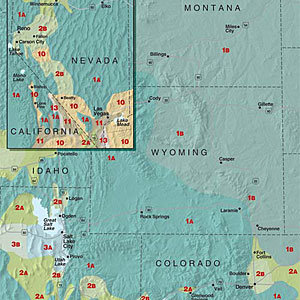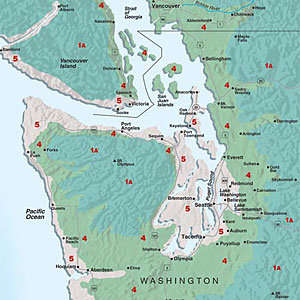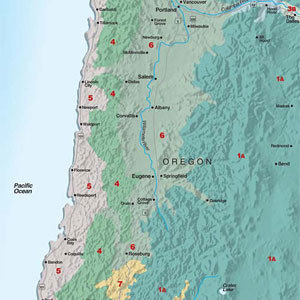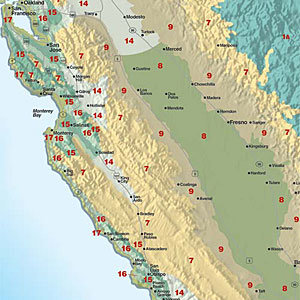Our Guide to Climate Zones for Gardening in the West
How a plant grows depends on its climate—and our unique guide divides the West into 15 specific climate zones, to help your garden thrive
A plant’s performance is governed by the total climate: length of growing season, timing and amount of rainfall, winter lows, summer highs, humidity. Sunset’s climate zone maps take all these factors into account—unlike the familiar hardiness zone maps devised by the U.S. Department of Agriculture, which divide the U.S. and Canada into zones based strictly on winter lows. The U.S.D.A. maps tell you only where a plant may survive the winter; our climate zone maps let you see where that plant will thrive year-round. For more information, consult Sunset‘s National Garden Book and Western Garden Book.
Climate Zone 1: The Coldest Winters

Growing season: early June through Aug., but with some variation—the longest seasons are usually found near this zone’s large bodies of water. Frost can come any night of the year. Winters are snowy and intensely cold, due to latitude, elevation, and/or influence of continental air mass. There’s some summer rainfall.
Climate Zone 2: Second-Coldest Western Climate
Growing season: early May through Sept. Winters are cold (lows run from -3 degrees to -34 degrees F/-19 degrees to -37 degrees C), but less so than in Zone 1. In northern and interior areas, lower elevations fall into Zone 2, higher areas into Zone 1.
Climate Zone 3: Mildest High-Elevation and Interior Regions
Growing season: early May to late Sept.—shorter than in Zone 2, but offset by milder winters (lows from 13 degrees to -24 degrees F/-11 degrees to -31 degrees C). This is fine territory for plants needing winter chill and dry, hot summers.
Climate Zone 4: Cold-Winter Western Washington and British Columbia
Growing season: early May to early Oct. Summers are cool, thanks to ocean influence; chilly winters (19 degrees to -7 degrees F/-7 degrees to -22 degrees C) result from elevation, influence of continental air mass, or both. Coolness, ample rain suit many perennials and bulbs.
Climate Zone 5: Ocean-Influenced Northwest Coast and Puget Sound

Growing season: mid-April to Nov., typically with cool temperatures throughout. Less rain falls here than in Zone 4; winter lows range from 28 degrees to 1 degree F/-2 degrees to -17 degrees C. This “English garden” climate is ideal for rhododendrons and many rock garden plants.
Climate Zone 6: Oregon’s Willamette Valley

Growing season: mid-Mar. to mid-Nov., with somewhat warmer temperatures than in Zone 5. Ocean influence keeps winter lows about the same as in Zone 5. Climate suits all but tender plants and those needing hot or dry summers.
Climate Zone 7: Oregon’s Rogue River Valley, California’s High Foothills
Growing season: May to early Oct. Summers are hot and dry; typical winter lows run from 23 degrees to 9 degrees F/-5 degrees to -13 degrees C. The summer-winter contrast suits plants that need dry, hot summers and moist, only moderately cold winters.
Climate Zone 8: Cold-Air Basins of California’s Central Valley

Growing season: mid-Feb. through Nov. This is a valley floor with no maritime influence. Summers are hot; winter lows range from 29 degrees to 13 degrees F/-2 degrees to -11 degrees C. Rain comes in the cooler months, covering just the early part of the growing season.
Climate Zone 9: Thermal Belts of California’s Central Valley
Growing season: late Feb. through Dec. Zone 9 is located in the higher elevations around Zone 8, but its summers are just as hot; its winter lows are slightly higher (temperatures range from 28 degrees to 18 degrees F/-2 degrees to -8 degrees C). Rainfall pattern is the same as in Zone 8.
Climate Zone 10: High-Desert Arizona, New Mexico, West Texas, Oklahoma Panhandle, and Southwest Kansas

Growing season: April to early Nov. Chilly (even snow-dusted) weather rules from late Nov. through Feb., with lows from 31 degrees to 24 degrees F/-1 degree to -4 degrees C. Rain comes in summer as well as in the cooler seasons.
Climate Zone 11: Medium to High Desert of California and Southern Nevada
Growing season: early April to late Oct. Summers are sizzling, with 110 days above 90 degrees F/32 degrees C. Balancing this is a 3 1/2-month winter, with 85 nights below freezing and lows from 11 degrees to 0 degrees F/-12 degrees to -18 degrees C. Scant rainfall comes in winter.
Climate Zone 12: Arizona’s Intermediate Desert
Growing season: mid-Mar. to late Nov., with scorching midsummer heat. Compared to Zone 13, this region has harder frosts; record low is 6 degrees F/-14 degrees C. Rains come in summer and winter.
Climate Zone 13: Low or Subtropical Desert
Growing season: mid-Feb. through Nov., interrupted by nearly 3 months of incandescent, growth-stopping summer heat. Most frosts are light (record lows run from 19 degrees to 13 degrees F/-17 degrees to -11 degrees C); scant rain comes in summer and winter.
Climate Zone 14: Inland Northern and Central California with Some Ocean Influence
Growing season: early Mar. to mid-Nov., with rain coming in the remaining months. Periodic intrusions of marine air temper summer heat and winter cold (lows run from 26 degrees to 16 degrees F/-3 degrees to -9 degrees C). Mediterranean-climate plants are at home here.
Climate Zone 15: Northern and Central California’s Chilly-Winter Coast-Influenced Areas
Growing season: Mar. to Dec. Rain comes from fall through winter. Typical winter lows range from 28 degrees to 21 degrees F/-2 degrees to -6 degrees C. Maritime air influences the zone much of the time, giving it cooler, moister summers than Zone 14.